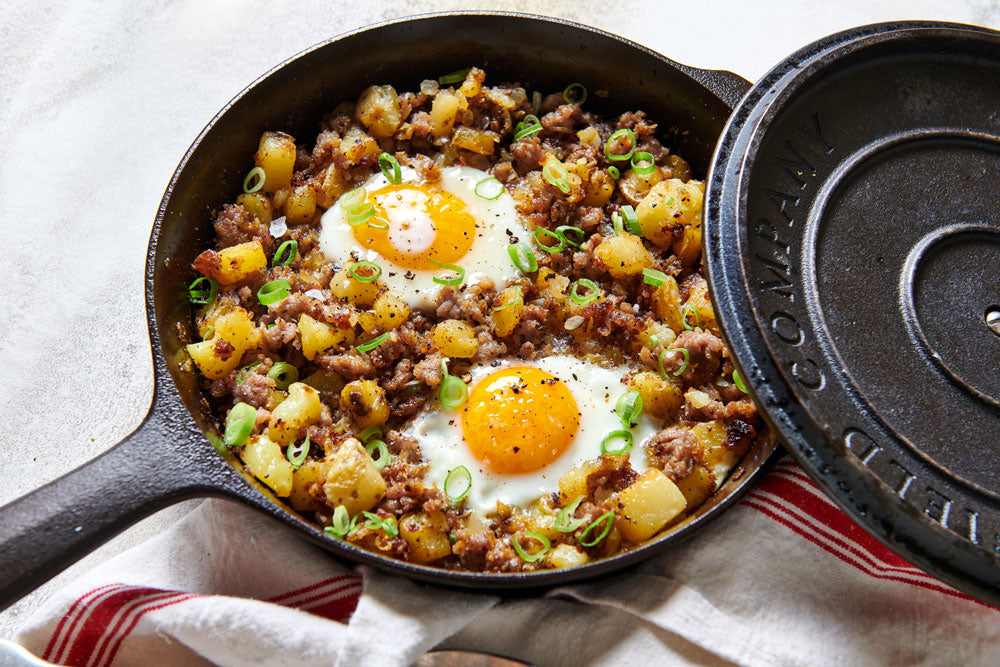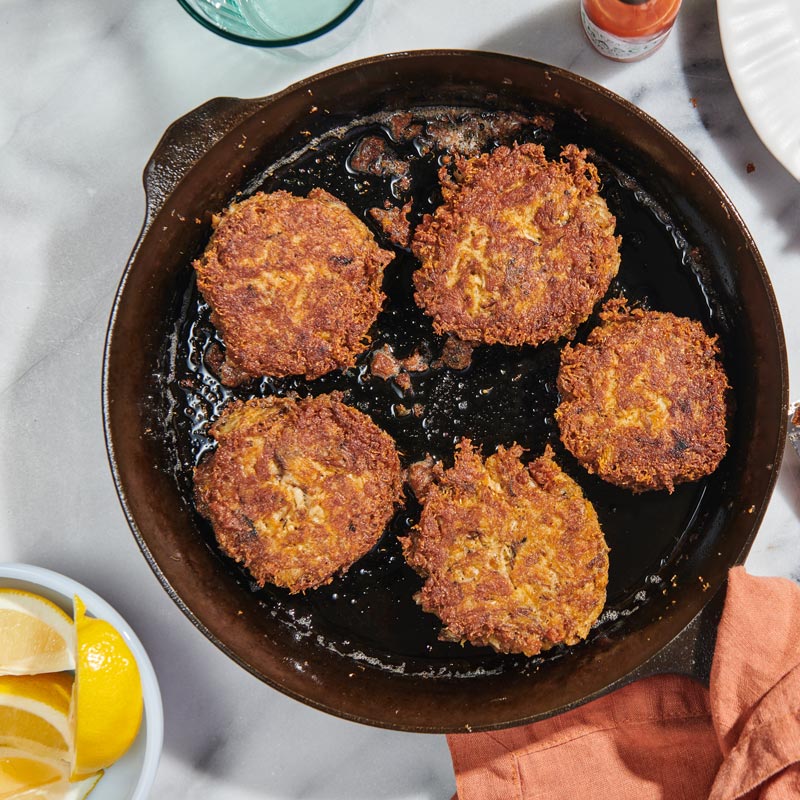We use skillets of all sizes when preparing breakfast, but more often than not we’re grabbing a No.6 Field Skillet when it comes time to make the morning meal. Why? Unless we’re cooking for a crowd, the No.6 is the perfect size for most anyday applications, from making eggs (fried, scrambled, baked, or sandwich'd) to knocking out a quick round of pancakes, to baking a single-serving Dutch baby.

But our favorite breakfast to make in a smaller cast iron skillet is hash. Breakfast hash is more of a formula than a recipe, wherein you combine something starchy (typically potatoes, sweet potatoes, or squash), something meaty (breakfast sausage, bacon, leftover proteins, etc.), and alliums (onions, leeks, and/or scallions), then finish the dish by cooking runny eggs on top. We like to throw in some extra vegetables and garnish the hash with fresh herbs as well, using the dish as an excuse to use up any leftovers lingering in the refrigerator.
Use the recipe below as a starting point for your hash adventure.
Field Notes:
This recipe is easy to scale up to serve more people. Double the recipe and cook it in a No.8 Field Skillet to make four servings, triple it and cook in a No.10 Field Skillet to serve six, or quadruple the recipe and cook it in a No.12 Field Skillet to serve 8.
Adding a splash of vinegar to the potato-cooking water helps the spuds fry up more brown and crispy.
Have leftovers from Thanksgiving? Swap in leftover roasted potatoes (or even mashed, spooned in dollops and fried so they crisp) for your base. Add shredded Brussels sprouts, green beans, or even crumbled stuffing—yes, stuffing gets golden and incredible in cast iron. Add chopped turkey or ham toward the end so it warms without drying out and crack an egg or two on it to turn yesterday’s sides into a crispy, savory, one-pan breakfast that tastes better than the feast itself.
Recipe: Cast Iron Breakfast Hash
Ingredients
2 medium russet or Yukon gold potatoes, cut into ½-inch cubes
1 tablespoon white vinegar
Extra-virgin olive oil
5 ounces loose breakfast sausage
Kosher salt and freshly ground black pepper
1 small onion, diced
2 eggs
1 tablespoon thinly sliced scallions (or other chopped herbs)
Tools
Resources
The Field Method for Cast Iron Care
Instructions
In a saucepan, cover the potatoes with an inch of water and add the vinegar. Bring the water to a boil. Reduce the heat and simmer the potatoes until just tender when pierced with a knife, about 10 minutes. Drain the potatoes and set aside.
Meanwhile, heat 1 tablespoon of olive oil in a No.6 Field Skillet over medium-high heat. Add the sausage and cook, breaking it up with a wooden spoon, until browned all over, 2 to 3 minutes. Transfer the sausage to a bowl, leaving behind as much fat as possible. Add the onion, lower the head to medium-low, and cook, stirring occasionally, until the onions are softened and started to brown in spots, 5 to 7 minutes. Transfer the onions to the bowl with the sausage.
Add another 2 tablespoons of olive oil to the skillet and increase the heat to high. Add the potatoes, season with salt and pepper and cook, stirring occasionally, until the potatoes are browned all over, 8 to 10 minutes. Add the sausage and onions, lower the heat to medium-low, and stir to combine.
Using a spoon, make two small divots in the hash, and crack an egg into each. Drizzle the tops of the eggs with olive oil. Cover the skillet with a lid and cook until the eggs are set, about 2 minutes. Season the hash to taste with salt and pepper, garnish with the scallions, and serve.
Seasoning Rating: Better
Breakfast dishes are great for cast iron seasoning—this hash recipe included. Whenever you heat oil on the cooking surface, you're likely to build a bit of new seasoning, and any recipe that uses the entire surface of the pan is more likely to build seasoning evenly.
To make clean-up easy, pay close attention to your taters. A less-cooked more starchy potato is more likely to stick to the pan and create dark, crispy residue. Par-boiling, rinsing, and using plenty of oil are great ways to minimize sticking, but if you end up with a bit of crust on the cooking surface, that's OK. Use your chain mail scrubber to tackle any stubborn bits, and follow the Field Method for cast iron care to finish the job.
Seasoning Ratings:
Best—These dishes are the best options for building resilient seasoning, and surefire choices for getting tricky pans back on track.
Better—The best way to keep your skillet in great shape is to cook frequently, and cast iron-friendly dishes like these are your bread and butter.
Safe—These recipes won't strip seasoning away from your pan, but won't really add any, either.
OK—Be sure to clean up promptly. Recipes with this rating might feature acidic ingredients which can affect seasoning if not washed soon after cooking.




